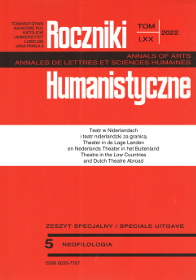Obrazy Niderlandów w nigdy niewystawionej dwuaktowej sztuce Rudolfa Slobody Wojna z małymi Niderlandami (1965)
Abstrakt
Słowacki pisarz Rudolf Sloboda uważany jest za jednego z czołowych autorów literatury słowackiej po II wojnie światowej. Jego twórczość obejmuje nie tylko prozę, którą według znawczyni Slobody Zory Pruškovej można nazwać niezwykle autobiograficzną, poezję, eseje oraz książki dla dzieci, lecz także kilka scenariuszy filmowych i dwa dramaty. Większość biografów często zapomina o dwuaktowej sztuce, opublikowanej w 1965 r. w dwóch numerach czasopisma literackiego Slovenské pohľady jako Vojna s malým Holandskom, ponieważ nigdy jej nie wystawiono.
W artykule omówiono cechy tej sztuki, a także przedstawiono kontekst jej powstania, na którym odcisnęła się cenzura reżimu komunistycznego. We wnioskach autor zauważa, że nazwy geograficzne i postaci przedstawione w sztuce pozwalają na hipotezę, iż Sloboda stworzył chronotopiczny odpowiednik Króla Ubu Alfreda Jarry’ego, przedstawiający Holandię jako abstrakcyjną koncepcję.
Bibliografia
‘The Final Cut: Holgyeim és Uraim’. Dalfar, 25 mrt. 2015, www.dalfar.wordpress.com/2015/03/25/the-final-cut-holgyeim-es-uraim. Geraadpleegd op 11 nov. 2020.
‘Ubu Roi’. Wikipedia, 5 nov. 2021, www.nl.wikipedia.org/wiki/Ubu_roi.
Bachtin, Michail. ‘Forms of Time and of the Chronotope in the Novel’. The Dialogic Imagination, geredigeerd door Michael Holquist. U of Texas P, 1981, pp. 84-258.
Delbeke, Astrid. Een blik op de stad. De beeldvorming van het Gentse stadslandschap in de literatuur en de fotografie. Universiteit Gent, Faculteit Letteren en Wijsbegeerte, niet-gepubliceerde masterscriptie, 2010.
Dominte, Carmen. ‘The Stage as the Chronotope of Memory’. The University of Bucharest Review, vol. 3, nr. 2, 2013, pp. 73-79.
Foucault, Michel. ‘Des Espaces Autres’. Architecture, Mouvement, Continuité, n 5, octobre 1984, pp. 46-49.
Istropolitán. Slovenský katolický spolok.. www.istropolitan.sk/2003/05/07/citacka-hry-r-slobodu-%25E2%2580%259Evojna-s-malym-holandskom%25E2%2580%259C/+&cd=1&hl=sk&ct=clnk&gl=sk. Geradpleegd op 11 nov. 2020.
Keunen, Bart. Verhaal en verbeelding. Chronotopen in de Westerse verhaalcultuur. Academiapress, 2007.
Leerssen, Joep. ‘A Summary of imagological theory’. Imagologica.eu, www.imagologica.eu/theoreticalsummary. Geraadpleegd op 22 jun. 2021.
Meulenare, Annelies de. De idyllische ruimte in de twintigste-eeuwse cultuur. Een analyse van idyllische chronotopen via het spatialiserende denken. Universiteit Gent, Faculteit Letteren en Wijsbegeerte, niet-gepubliceerde licentiaatscriptie, 2007.
Prušková, Zora. Rudolf Sloboda. Kalligram, 2001.
Sabbe, Anke. Theater als oppositiemedium. Onderzoek naar theater tijdens de val van het communisme in Tsjechië en Polen. Universiteit Gent, Faculteit Letteren en Wijsbegeerte, niet-gepubliceerde masterscriptie, 2013.
Sloboda, Rudolf. ‘Vojna s malým Holandskom’. Slovenské pohľady, vol. 81, nr. 6, 1965, pp. 144-156, en nr. 7, pp. 147-157.
Sloboda, Rudolf. Pokus o autoportrét. Slovenský spisovateľ, 1988.
Sloboda, Rudolf. Z Tvorby. Tatran, 2002.
Žemberová, Viera. ‘Literatúra vložená do záznamov’. Proudy, středoevropský časopis pro vědu a literaturu. www.phil.muni.cz/journal/proudy/filologie/materialy/2018/2/zemberova_literatura_vlozena_do_zaznamu.php. Geradpleegd op 10 Nov. 2020.
Copyright (c) 2022 Roczniki Humanistyczne

Utwór dostępny jest na licencji Creative Commons Uznanie autorstwa – Użycie niekomercyjne – Bez utworów zależnych 4.0 Międzynarodowe.





